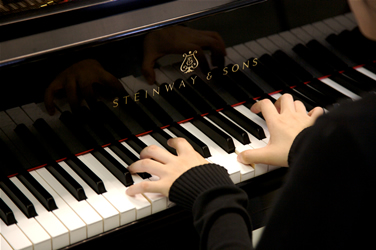Hill Hall was almost literally packed like sardines for the December 2 concert of the University of North Carolina Symphony Orchestra under Music Director Tonu Kalam’s baton, and so many musicians were available that a substantial number were rotated between the stage and hall during the course of the program. In sheer numbers, Kalam fields the largest orchestra that we know of in the state. There was a swath of some nineteen cellos and a dozen violas shadowed by seven double-basses. With the two violin sections, either one of which would have equaled most state orchestras’ entire rosters, the brass never stood a chance of drowning the strings. For the eager audience of friends, relatives, and music lovers, it was standing room only.
Some of the most listener-friendly 20th-century music was composed by the members of the so-called “Pastoral” school of English composers, and one of the most significant works in this genre is Gerald Finzi’s Clarinet Concerto in C Minor, Op. 31 (1949). After WWII, the shy composer settled near Newbury, England, where, according to unsigned program notes for the Naxos recording of the concerto, “he indulg(ed) an interest in apple growing” and conducted an amateur group, the Newbury String Players. This latter experience paid dividends in developing his understanding of the possible nuances of composing for strings. This is everywhere evident in the extensive divided-string writing that abounds in this concerto. Faculty member Donald L. Oehler seemed to have limitless breath control as he wove a seamless melodic line set against a varied tapestry of strings. All string sections played with tight ensemble, ever alert to sudden changes and adapting as one to them. There was only a fleeting tinge of sourness during the loud and brusque opening tutti. Oehler excelled with a number of brilliant trills, and his clarinet sang with a fine mellow tone as it coursed from the top to the bottom of its range. His playing of the cadenza that Vaughan Williams persuaded Finzi to add after the premiere was plangent. All of this was surrounded by a constantly changing fabric of gossamer and, sometimes, otherworldly divided strings.
Schubert’s “Unfinished” Symphony (No. 8 in B Minor, D. 759) is certainly a war-horse; collectors in the days of Lps could hardly avoid having dozens of copies of it since its brevity made it a popular filler. By ensuring crisp attacks and allowing the melodies to breathe naturally, Kalam dusted off all traces of routine and made the work seem newly minted. With the strings garrisoned in depth, the balances were ideal, and there was some fine subtle playing by the horns and trombones. The second movement abounded in good woodwind solos from the clarinet, flutes and oboe. The hall basked in the glow of the well-known cello melody.
A half-century dominated by academic serial compositions has made us wary of new works, so it was a rare delight to be swept off one’s feet by a contemporary piece at first hearing! Christopher Theofanidis, currently based at the Peabody Conservatory in Baltimore and the Juilliard School in New York City, composed “Rainbow Body” in 2002 for the Houston Symphony and conductor Robert Spano, who recorded it with the Atlanta Symphony. The work won the Masterprize 2003 and has been taken up by many orchestras, including the Charlotte Symphony (in mid-October) and the UNCSO, which played it as part of last month’s Milestones 2004 Music Festival (reviewed by colleague Ken Hoover). “Ave Maria, O auctrix vite,” a chant by Hildegard von Bingen, the 12th-century visionary and mystic, is used as the basis of the work, with fragments of the melody introduced in various sections of the orchestra. The composer creates a “sonic halo” effect around the melody to mimic sound within a cathedral space. There were gorgeous shimmering waves of sounds from the strings in the nearly static beginning. Principal cellist Michael Lotito was superb in his challenging and dramatic solo. The more turbulent middle portion features a bongo and other percussion along with bells. As the brilliant finish approached, the entire cello section took up the theme, adding to the effect of a cresting wave of sound.











